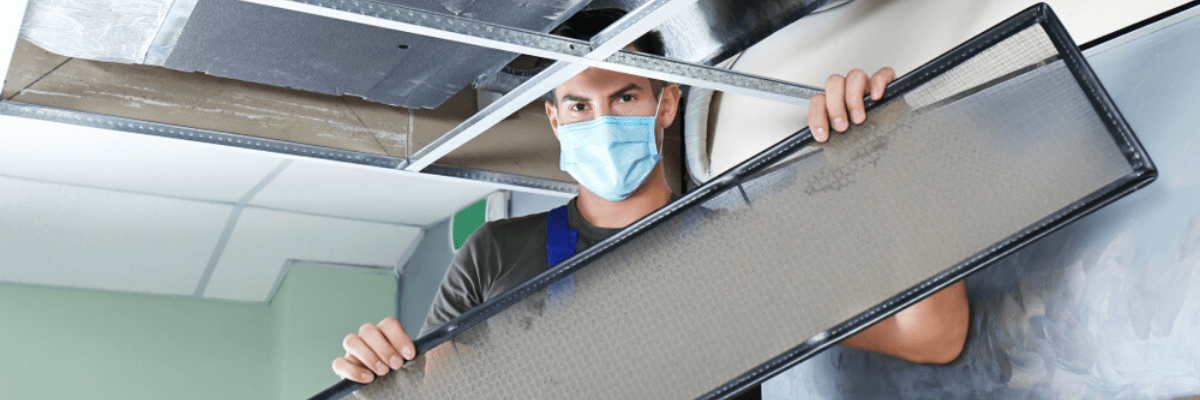The COVID-19 pandemic has raised many questions, especially from commercial customers, about the potential for transmission of the virus through HVAC systems. Business owners and managers want to understand the risks and learn what steps they can take to keep their employees and customers safe.
In many cases, HVAC field service technicians are the primary point of contact between the customer and the service company. That’s why it’s important that technicians have an understanding of the issues and how to best answer customer questions.
Here’s a primer for service technicians with helpful information about COVID and HVAC systems.
COVID and HVAC systems: what is the risk of transmission?
The question many customers are asking is this: “Can the COVID-19 virus get into my HVAC system and be dispersed throughout my space?”
It’s not a simple question to answer, especially since there hasn’t been time yet for definitive testing. Here are the facts as we know them now.
To date there is no conclusive evidence that the virus has been transmitted through a ducted HVAC system.
That said, a growing number of experts do believe that airborne transmission is a possibility. Just this week, a group of 239 scientists asked the WHO, CDC, and other health agencies to recognize mounting evidence that the virus can spread via tiny droplets from infected people that can float in the air for up to 3 hours—long enough to infect others nearby.
The amount of time droplets containing the virus can remain airborne is hard to predict because it depends a great deal on the conditions in the space. In theory, it may be possible for particles to stay in the air long enough to enter a ducted HVAC air distribution system.
However, experts believe that the risk of transmission this way is small. The primary method of transmission is direct contact with an infected person. That’s why HVAC experts are recommending that any HVAC-related mitigation tactics are implemented as part of an overall strategy that targets the primary means of virus transmission, including social distancing, wearing masks, and handwashing.
Even though the risk of COVID transmission through HVAC is believed to be small, many businesses want to do everything they can to keep people safe. There are tactics that can help to prevent virus particles that may enter an air distribution system from being transmitted throughout the space. However, customers must understand that none of these tactics is foolproof, and some have disadvantages.
COVID mitigation strategies for HVAC systems
These are some of the tactics that can help to prevent transmission of the virus through HVAC systems.
Deep clean HVAC system components including coils, air handlers, and ductwork. Some service providers are offering a deep cleaning of HVAC components where virus particles may settle, which can be done prior to reopening a space (especially spaces with known exposure to the virus).
It’s important to communicate to customers, however, that a one-time cleaning offers no lasting protection against future virus contamination.
Improve HVAC air filtration. Virus particles that manage to make their way into an HVAC air distribution system have the chance to be trapped by HVAC filters, so they can’t spread into other parts of the building or space. The problem is, most standard filters have holes that are too large to trap coronavirus particles. That’s why some (including New York Governor Cuomo) are recommending the use of higher efficiency filters that are better able to trap tiny virus particles.
There are a number of downsides to this strategy:
- Using higher efficiency filters can decrease cooling capacity and increase energy bills, since the system has to run longer to reach set temperatures.
- There’s also more wear and tear on system parts, which can lead to repair issues.
- Higher efficiency filters can cost up to 3 times more than standard ones, and they need to be changed more frequently.
- Not every system can accommodate high efficiency filters.
Control humidity. The COVID-19 virus thrives at low humidity levels. Adding moisture to indoor air may damage virus particles and also make tiny droplets less likely to linger in the air. However, too much humidity is not ideal either, because excess moisture can damage furnishings and finishes. Experts generally recommend keeping relative humidity levels within a moderate range of 40 to 60 percent, although the optimal level depends on your space and its usage.
Add ventilation. HVAC experts (including ASHRAE) have also recommended increasing ventilation (bringing in more outdoor air) to dilute the concentration of virus particles in indoor air.
Consider new technology that destroys virus particles. Surface and air cleaning devices can be installed within HVAC systems to kill particles on equipment and within air flowing through it. Standalone air purification devices can also be used in a single room. Some options include UV light disinfection systems and ionizers that use ionized hydrogen peroxide to destroy viruses and other microbes in the air.
UV light technology shows promise but has yet to be proven effective against COVID-19. There is some evidence that ionizers can destroy coronavirus particles. Customers should be advised that they will need to weigh the costs of these devices against a possible (but not guaranteed) benefit.
Your employer’s COVID-related policies, protocols, and offerings
In addition to understanding the facts and information provided above, service technicians must also be able explain their employer’s work policies, health and safety practices, and the mitigation products and services they are offering.
Work policies. For example, how is your employer monitoring the health of employees and making sure no one who shows symptoms or might have been exposed to the virus is working in the field?
Health and safety protocols. For example, you can explain how you’re using PPE to keep customers safe (such as gloves, masks, face shields), and disinfecting surfaces you have touched while working on equipment.
COVID mitigation products and services. Which of the above mitigation products and services does your employer offer? Be prepared to talk about them with customers in response to questions, or proactively if your employer asks you to do so.
More resources for HVAC service technicians
Check out our resource center for educational content that can help you boost your career in HVAC service.

